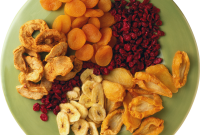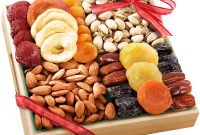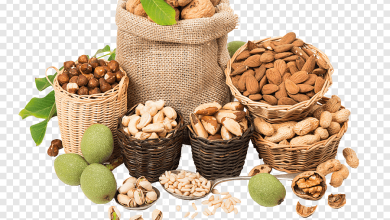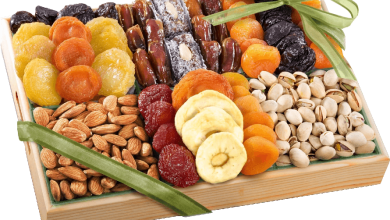
Fruit that has been dried out by removing its water content, either naturally through solar dehydration or artificially using specialized dehydrators, is referred to as dried fruit. Fruit’s inherent sugars are concentrated when it is dried, giving it a sweet, frequently chewy or slightly firm texture. Here are a few different kinds of dried fruit:
- Raisins:
- Usually Thompson seedless grapes that have been dried produce petite, delicious, wrinkled fruits.
- Dates:
- Dried fruit from the date palm that is frequently soft and sweet and has a flavor similar to caramel.
- Apricots:
- Dried apricot halves can be processed with sulfur dioxide for a brilliant orange color and preserved quality, or they can be dried naturally in the sun.
- Prunes:
- Dried plums are prized for their inherent sweetness and chewy, soft texture.
- Figs:
- Figs that have been dried have a naturally sweet and slightly chewy texture.
- Cranberries:
- Due to the sharpness of fresh cranberries, dried cranberries are frequently sweetened and used in a variety of cuisines.
- Bananas:
- Banana slices that have been dehydrated produce a chewy and sweet snack.
- Apples:
- Dried apple rings or chips with a sweet, fruity flavor and a crispy or chewy texture.
- Cherries:
- Dried cherries are bursting with flavor and are sold sweetened or unsweetened.
- Blueberries:
- Dried blueberries have a sweet and tart flavor and are frequently used as snacks or in baking.
- Pineapple:
- pineapple chunks or rings that have been dried out; they have a pleasant, tropical flavor.
- Mango:
- Slices of dried mango, renowned for their chewy texture and sweet, tropical flavor.
You can eat dried fruits as snacks, add them to cereals, baked products, salads, and other dishes to improve their flavors and textures. Due to their intense sugar content, dried fruits should be eaten in moderation.
To benefit from the benefits of dried fruits while limiting their calorie and sugar content, their consumption must be done in moderation. It’s essential to read labels and, if possible, choose dried fruit that hasn’t been heavily processed or sweetened. You should seek individualized advice from a healthcare professional or nutritionist, particularly for those with specific dietary concerns.
Dried fruits offer both advantages and disadvantages, and understanding these can help individuals make informed decisions about their consumption.

Advantages and Disadvantages:
Advantages of Dried Fruits:
- Long Shelf Life:
- Fruits can be dried to remove water, prolonging their shelf life without the use of chemicals and making them a more practical and durable dietary alternative.
- Portability and Convenience:
- Dried fruits are a practical snack choice for active lives because they are portable, lightweight, and don’t need to be refrigerated.
- Concentrated Nutrients:
- Fruits’ contents are concentrated by drying, delivering important vitamins, minerals, fiber, and antioxidants in a concentrated form.
- Natural Sweetness:
- Fruits with natural sugars that have been enhanced by drying have a sweet flavor without any additional sugar or additives.
- Fiber Content:
- Dietary fiber, which is abundant in dried fruits, maintains a healthy digestive system, aids in digestion, and helps keep people feeling full.
- Rich in Antioxidants:
- High quantities of antioxidants are frequently still present in dried fruits, helping to fight oxidative stress and lower the risk of developing chronic diseases.
- Versatility in Use:
- To add taste and nutrition to a wide range of recipes, dried fruits can be used in salads, baking, frying, and as a topping for yogurt or cereal.
Disadvantages of Dried Fruits:
- High Sugar Content:
- Dried fruits have a high natural sugar content because drying concentrates sugars. Excessive consumption may not be ideal for people watching their sugar intake and can contribute to a high calorie intake.
- Calorie Density:
- Due to their high calorie content, dried fruits may cause weight gain if consumed in excess. A little portion might contain a lot of calories.
- Sulfur Dioxide and Additives:
- To maintain color and increase shelf life, some dried fruits are treated with sulfur dioxide or other chemicals. Some people may experience allergic reactions to sulfur dioxide.
- Loss of Some Nutrients:
- Minerals and fiber are largely unaffected by drying, but some heat-sensitive vitamins, such vitamin C and folate, may be lost during the process.
- Digestive Issues for Some:
- Due to their high fiber content, dried fruits can cause digestive problems, such as bloating or gas, particularly if ingested in excessive amounts.
- Potential for Dental Issues:
- If good oral hygiene is not practiced, the high sugars in dried fruits may cause tooth decay and other dental problems.

Fruit that has been dried out by removing its water content, either naturally through solar dehydration or artificially using specialized dehydrators, is referred to as dried fruit.
To reap the benefits of dried fruits while limiting their calorie and sugar content, consumption should be done in moderation. It’s crucial to read labels and, whenever feasible, pick dried fruits that haven’t been heavily processed or sweetened. It is recommended to seek out individualized guidance from a healthcare provider or nutritionist, especially for people with particular dietary issues.



